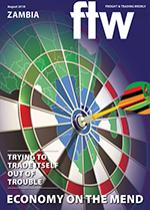Centrally placed Zambia, which shares its borders with eight countries, is attempting to turn what has been seen as a natural disadvantage into a competitive advantage.
It has joined the growing number of African countries that see themselves as “landlinked” rather than “landlocked”. Transport and communication minister Brian Mushimba is quoted as saying
“Zambia ought to exploit its geographical vantage point by creating a regional hub suitable for all forms of investment considering the fact that its centrality taps into Comesa, SADC and the Great Lakes region which account for more than 600 million people. Now that’s a ready market for all sorts of businesses in the area”.
The 600 million potential customers are no further than 2 000 kilometres from Zambia. The 7th National Development Plan 2017-2021 recognises the importance of a modern and well-maintained logistics infrastructure. Listed as one of the “binding constraints to economic diversification and job creation” is “inadequate levels and low quality of infrastructure development which lead to low economic activity and high production costs resulting in low competitiveness.
“Critical infrastructure, such as housing, electricity, feeder roads, rail, air and water transport, and water supply and sanitation has not been adequate to facilitate the desired levels of economic transformation and leverage private investment,” it states. The government has put its money where its good intentions are, and over the past five years it has been investing heavily in road and rail infrastructure.
There is a downside. External loan debt has soared to US$9.3bn from US$2bn in 2011, and there are now serious concerns about the ability of the government to pay off or even service the debt. Many analysts believe that it is higher than the US$9.3 billion estimate given by government. Zambia approached the International Monetary Fund (IMF) in 2014 after a plunge in the copper price. In order to qualify for IMF funding in the form of a US$1.3- billion loan the government is having to cut back on infrastructure spending, and to look at partnerships with private enterprise.
Higher copper prices are helping to ease some pressure on government coffers. Copper accounts for more than 70% of exports. Government put economic growth at 4.1% in 2017, and it is expected to be about 4% in 2018. Zambia is also trying to trade itself out of trouble. Despite the debt cloud the government is forging ahead with the crafting of a new transport policy designed to transform the country into a regional transport hub with integrated transport systems supporting socio-economic development.
Included in the plans are the reintroduction of a national airline by October this year and the building of an Nseluka-Mpulungu rail link that will connect the existing Tanzania Zambia rail line at Nseluka in northern Zambia via Mbala to Mpulungu harbour on the Great Lakes.
“The railway line is expected to connect Zambia to the Great Lakes region (Burundi, Rwanda, Congo and Tanzania) to boost trade along the Great Lakes Corridor. It is also envisaged that bulk and heavy cargo such as sugar, cement, coffee and some minerals currently being hauled by road, will be transported by rail thereby prolonging the life span of road infrastructure,” states the ministry of transport and communications in its request for expressions of interest in a public-private partnership to build the line.
Feasibility studies have been completed for the construction of a new harbour at Mpulungu Port on Lake Tanganyika, which is estimated to cost around US$50 million. Two other planned rail links are the Chipata-Petauke-Serenje line to Nacala and the Chingola-Solwezi-Jimbe line on the border with Angola. If completed these two lines will change the logistics dynamics within the sub-region as they will give shippers an alternative to the existing ports of Durban, Walvis Bay and Dar es Salaam.
Grounded in 1995, Zambia Airways is expected to take off again in partnership with Ethiopian Airlines. The airline is part of a greater strategy which has seen investment in the Kenneth Kaunda and Copperbelt international airports.
However, further investment in roads, rail, port and air infrastructure will be stalled until the government has brought external debt under control. For that, it may have to make concessions to the Chinese government as the bulk of the loans are from Chinese institutions.
And that would introduce a whole new dynamic into Zambia’s plans to be a regional logistics hub.
INSERT
Zambia ought to exploit its geographical vantage point by creating a regional hub. – Brian Mushimba

